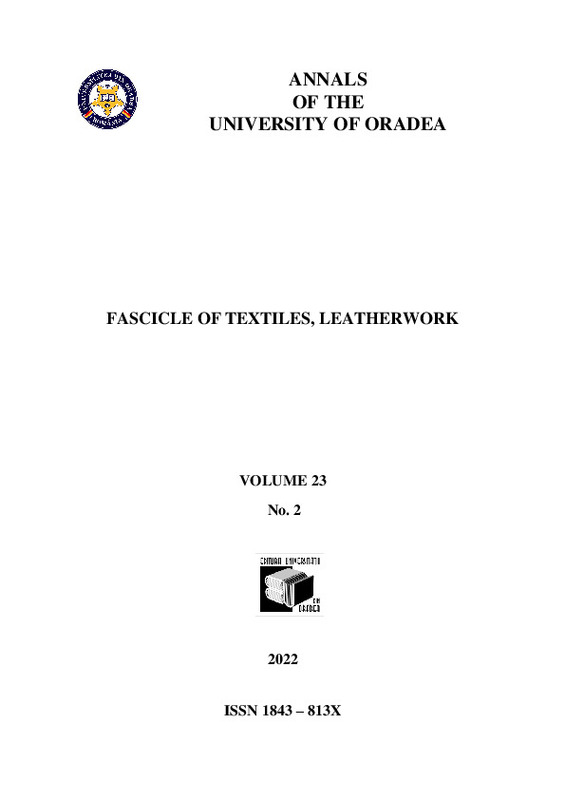JavaScript is disabled for your browser. Some features of this site may not work without it.
Buscar en RiuNet
Listar
Mi cuenta
Estadísticas
Ayuda RiuNet
Admin. UPV
ESTIMATING mg CO2 GENERATED FROM A COTTON FABRIC DEGRADATION
Mostrar el registro sencillo del ítem
Ficheros en el ítem
| dc.contributor.author | Sánchez-Martínez, Ainhoa
|
es_ES |
| dc.contributor.author | Belda-Anaya, Raquel
|
es_ES |
| dc.contributor.author | BONET-ARACIL, MARILÉS
|
es_ES |
| dc.contributor.author | Capablanca, Lucía
|
es_ES |
| dc.contributor.author | Gisbert Paya, Jaime
|
es_ES |
| dc.date.accessioned | 2023-10-26T18:02:20Z | |
| dc.date.available | 2023-10-26T18:02:20Z | |
| dc.date.issued | 2022 | es_ES |
| dc.identifier.issn | 1843-813X | es_ES |
| dc.identifier.uri | http://hdl.handle.net/10251/198877 | |
| dc.description.abstract | [EN] Nowadays, concern about sustainability is a fact. Textile industry is considered as one of the most pollutants. There is an increase interest in quantifying the pollution generated by textiles. The chemicals and water used by textile industry are considerable. However, water consumption and wastewater are not the only drawback form textile sector. Greenhouse gases are important pollutants as well. It is necessary to measure pollution, in order to design and apply mecanisms to reduce the one generated from textiles, it is also important to improve product stewardship and control the value chain. This article establishes a method to evaluate the accelerated biodegradability by burial in compost of textile materials. In our experiment, a respirometric technique has been used to estimate the production of CO2 through the comparison of results between the textiles to be analyzed against a reference product, which corresponded to a microcrystalline cellulose, and the ecosystem itself, without fibers. This test has allowed adjusting the reactions for reagent consumption volumes within an acceptable range. The results obtained have made it possible to validate the analysis method, since the process shows sufficient sensitivity to obtain significant differences between the analyzed samples which are microcrystalline cellulose and a sample from cotton fabric. | es_ES |
| dc.language | Inglés | es_ES |
| dc.publisher | Universită | es_ES |
| dc.publisher | ţ | es_ES |
| dc.publisher | ii din Oradea | es_ES |
| dc.relation.ispartof | Annals of the University of Oradea: Fascicle of Textiles, Leatherwork | es_ES |
| dc.rights | Reconocimiento - No comercial (by-nc) | es_ES |
| dc.subject | Biodegradability | es_ES |
| dc.subject | Cellulose | es_ES |
| dc.subject | Greenhouse gas | es_ES |
| dc.subject | Sustainability | es_ES |
| dc.subject | Environment | es_ES |
| dc.subject | Fiber | es_ES |
| dc.subject.classification | INGENIERIA TEXTIL Y PAPELERA | es_ES |
| dc.title | ESTIMATING mg CO2 GENERATED FROM A COTTON FABRIC DEGRADATION | es_ES |
| dc.type | Artículo | es_ES |
| dc.rights.accessRights | Abierto | es_ES |
| dc.contributor.affiliation | Universitat Politècnica de València. Escuela Politécnica Superior de Alcoy - Escola Politècnica Superior d'Alcoi | es_ES |
| dc.contributor.affiliation | Universitat Politècnica de València. Departamento de Ingeniería Textil y Papelera - Departament d'Enginyeria Tèxtil i Paperera | es_ES |
| dc.description.bibliographicCitation | Sánchez-Martínez, A.; Belda-Anaya, R.; Bonet-Aracil, M.; Capablanca, L.; Gisbert Paya, J. (2022). ESTIMATING mg CO2 GENERATED FROM A COTTON FABRIC DEGRADATION. Annals of the University of Oradea: Fascicle of Textiles, Leatherwork. 23(2):59-63. http://hdl.handle.net/10251/198877 | es_ES |
| dc.description.accrualMethod | S | es_ES |
| dc.relation.publisherversion | http://textile.webhost.uoradea.ro/Annals/Volumes.html | es_ES |
| dc.description.upvformatpinicio | 59 | es_ES |
| dc.description.upvformatpfin | 63 | es_ES |
| dc.type.version | info:eu-repo/semantics/publishedVersion | es_ES |
| dc.description.volume | 23 | es_ES |
| dc.description.issue | 2 | es_ES |
| dc.relation.pasarela | S\482119 | es_ES |






